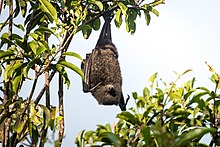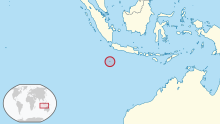| Christmas Island flying fox | |
|---|---|

| |
| Scientific classification | |
| Domain: | Eukaryota |
| Kingdom: | Animalia |
| Phylum: | Chordata |
| Class: | Mammalia |
| Order: | Chiroptera |
| Family: | Pteropodidae |
| Genus: | Pteropus |
| Species: | |
| Subspecies: | P. m. natalis
|
| Trinomial name | |
| Pteropus melanotus natalis | |

| |
| Location of Christmas Island | |
| Synonyms[3] | |
| |
The Christmas Island flying fox or Christmas Island fruit bat, as the name suggests, is a flying fox endemic to Christmas Island. It is unclear if it should be considered a distinct species (Pteropus natalis), or a subspecies of the black-eared flying fox (P. melanotus natalis). It may descend from a population of island flying foxes from Pulau Panjang near Java.
The Christmas Island flying fox is medium-sized, averaging 400 g (14 oz).[4] It has mainly black fur, but slight variations exist. It gives birth to one pup (generally during the wet season from December to March), which can fly by five or six months, and reaches sexual maturity by 27 or 28 months, which is one of the slowest maturation times of any bat.[4] Life expectancy is thought to be 6 to 12 years. It forages across the island for fruit and nectar, and, being one of two animals on the island to do so, is likely a keystone species, important in seed dispersal and pollination. Unlike most other bats, it often starts foraging a few hours before sunset (partial diurnality).
Due to human activity, it is the sole remaining native mammal species on the island. The population has gone into sharp decline, reduced by 66–75% between 1984 and 2006, and by 35–39% from 2006 to 2012. Causes of the decline likely include development of the island, invasive species, and phosphate mining and resultant cadmium poisoning.[5] The species is considered critically endangered,[6] and if the population trend is maintained, Christmas Island flying foxes are likely to become extinct in the near future.[7]
- ^ Cite error: The named reference
IUCN2021was invoked but never defined (see the help page). - ^ Thomas, Oldfield (1887). "Report on a zoological collection made by the officers of H.M.S. 'Flying Fish' at Christmas Island. I. Mammalia". Proceedings of the Zoological Society of London. 1887. Academic Press, [etc.]: 511–14.
- ^ Cite error: The named reference
MSW3was invoked but never defined (see the help page). - ^ a b Cite error: The named reference
Todd2018was invoked but never defined (see the help page). - ^ Cite error: The named reference
EWG2010was invoked but never defined (see the help page). - ^ Cite error: The named reference
SPRAT2014was invoked but never defined (see the help page). - ^ Geyle, Hayley M.; Woinarski, John C. Z.; Baker, G. Barry; Dickman, Chris R.; Dutson, Guy; Fisher, Diana O.; Ford, Hugh; Holdsworth, Mark; Jones, Menna E.; Kutt, Alex; Legge, Sarah; Leiper, Ian; Loyn, Richard; Murphy, Brett P.; Menkhorst, Peter (2018-04-20). "Quantifying extinction risk and forecasting the number of impending Australian bird and mammal extinctions". Pacific Conservation Biology. 24 (2): 157–167. doi:10.1071/PC18006. hdl:10536/DRO/DU:30109156. ISSN 2204-4604.
